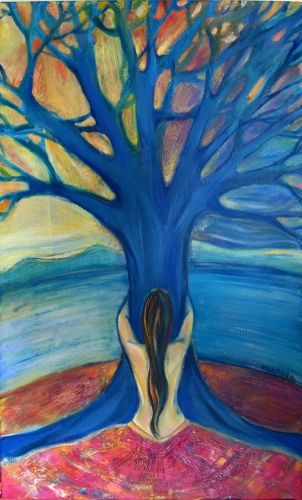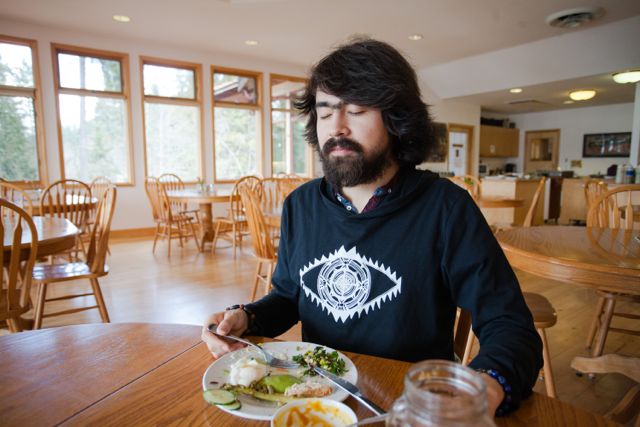By Tracie Nichols
A kind-eyed man gently wraps a wide band of orange fabric the color of his robes around a trunk, tying it with firm finality.
Pharakru Pitak Nanthakthan, the Abbot of Wat Arunyawas, has just ordained another tree.
In response, my heart thuds and leaps shouting “What a beautiful practice!” How courageous to overtly acknowledge trees inherent sacredness. How wise and loving!
Abbot Nanthakthan began this practice in Thailand in the 1990s because he worried about the world and the number of trees being thoughtlessly cut. He saw the impact losing these trees had on communities and wanted to do what he could to stop it.
“The world is holy. We are holy. All life is holy. Daily prayers are delivered on the lips of breaking waves, the whisperings of grasses, the shimmering of leaves.” ~ Terry Tempest Williams
According to Abbot Nanthakthan, “Above all else, villagers respect monks in orange robes.” So, after searching sacred texts for a way to save them, he decided to ordain trees and put them in the same orange robes, encouraging the respect of their human neighbors.
He says, “When you ordain a tree, that tree becomes sacred. Once a tree is ordained, nobody wants to destroy it.”
Thinking about this, my leaping heart bounds toward trees and forests I know here at home in the U.S., and continues to slam still. I cannot think of any one spiritual, political or cultural symbol we collectively respect in the same way that Thai villagers respect orange robed monks. Except, sadly, money, but that’s a foundational reason for the cutting that tree ordination works to stop. We are too disparate in our beliefs.
The strength we so often find in diversity becomes an Achilles heel in this case.
“We have lived our lives by the assumption that what was good for us would be good for the world. We have been wrong. We must change our lives so that it will be possible to live by the contrary assumption, that what is good for the world will be good for us. And that requires that we make the effort to know the world and learn what is good for it.”~ Wendell Berry, The Long-Legged House
I find trees sacred, because they are my deep-rooted, tall-reaching, wind-whispering kin—without whom soul and body are inescapably impoverished. In truth, I hold all the great wild in my heart with the same reverence. I’ve changed my life, as Berry suggests, and do my best to live as if what is good for the world is good for me.
In my case, a profound personal trauma sparked an introspective journey resulting in my transformed thinking and believing.
The catalyst can be anything, though. It can be any life experience or choice that cracks open the confines of our tightly held assumptions and beliefs and gives us the chance to shift our perspective.
I know reverencing the earth in this way puts me in the minority. But, like Pharakru Pitak Nanthakthan, I’m worried about the world if we continue to lose trees and other members of our global ecosystem. I’m also stubbornly optimistic and relentlessly curious—traits I hopefully imagine underpin much of human consciousness. I’m convinced there is a way, no, make that a diversity of ways, to help all of us acknowledge and act on the inherent sacredness of nature.
David Abram unveils one way in this quote from his book Becoming Animal: An Earthly Cosmology. “Other animals, in a constant and mostly unmediated relation with their sensory surroundings, think with the whole of their bodies.”
Mmmm…let that settle into your awareness for a moment—“think with the whole of their bodies…”
While it’s true that most of us have lost touch with our ability to perceive with the whole of our bodies (If we were thinking that way, we’d never consider razing forests full of trees, because our lungs and heart would be outraged!), I believe it’s equally true we can re-access this skill if we engage our curiosity and willingness.
Stand near a tree and open your senses to its presence. You will eventually sense the tree’s “tree-ness.” I’ve seen it happen countless times. People “feel” the tree in their bones, muscles and cells—in their beating hearts. I suggest you savor the experience when it happens. It’s a wildly beautiful moment.
And, if that doesn’t work, consider your breath. Breathing, that involuntary survival necessity and—to some—sacred act, is something trees and people cannot do without the other. We literally make space for each other to live through exchanging oxygen and carbon dioxide gases.
Whatever your entry point, a monk’s act of ordaining a tree, a wild-haired crone woman’s act of sensing tree presence with reverence, looking at the essential nature of breathing, each action brings us closer to living in this world as if all life matters. As if, as Terry Tempest Williams says, “All life is holy.” And that’s the treasure hidden in all these words.
We must act as if all life is holy.
“You already speak tree. The trick to understanding them is to listen long enough, and closely enough, to decipher their particular dialect. Simply take a breath and listen…with your whole body & spirit.”~ Tracie Nichols
Here’s the original video news story from the BBC that inspired me to write this article. It is well worth watching…
Buddhist monk ordains trees to help the environment:
http://www.bbc.com/news/magazine-31650591
Photo: (source)
Editor: Dana Gornall
Comments
- Pay Attention Humans. The Little Brown Bat is in Danger. - May 23, 2015
- I’m Here. I Matter. - April 8, 2015
- Equinox: When The Earth Pauses Between Ebb And Flow. - March 20, 2015





